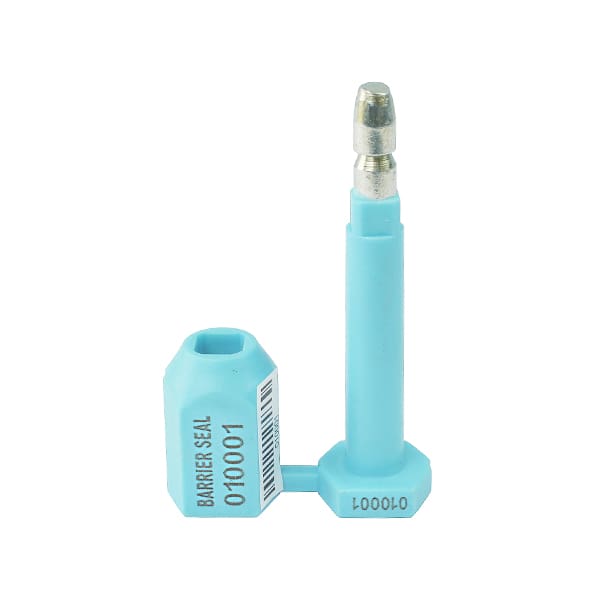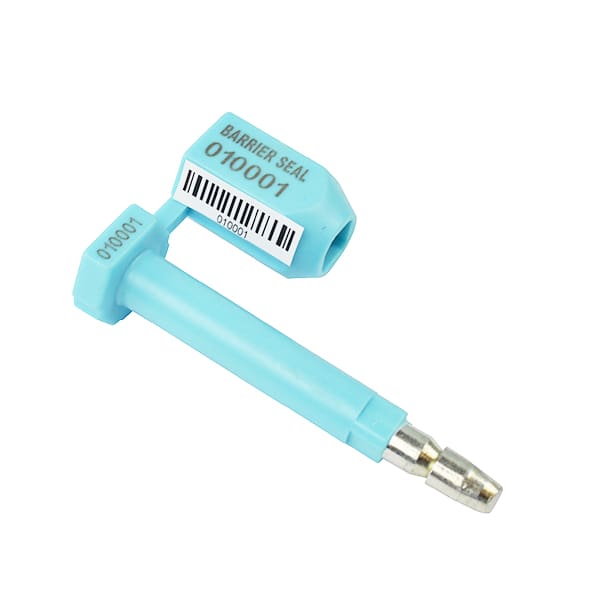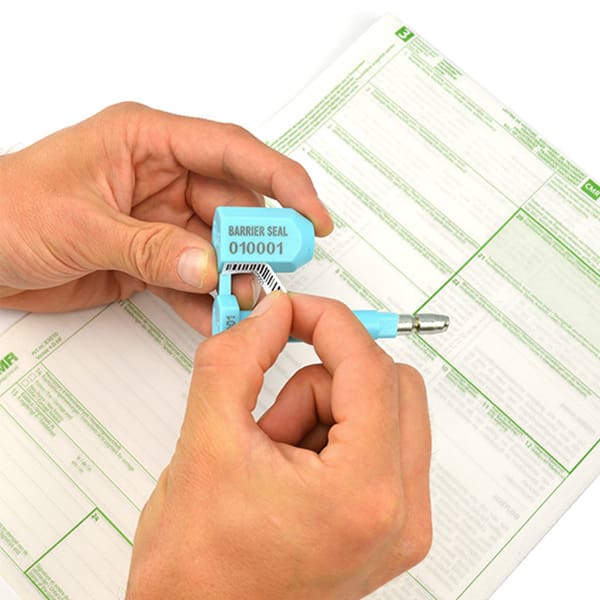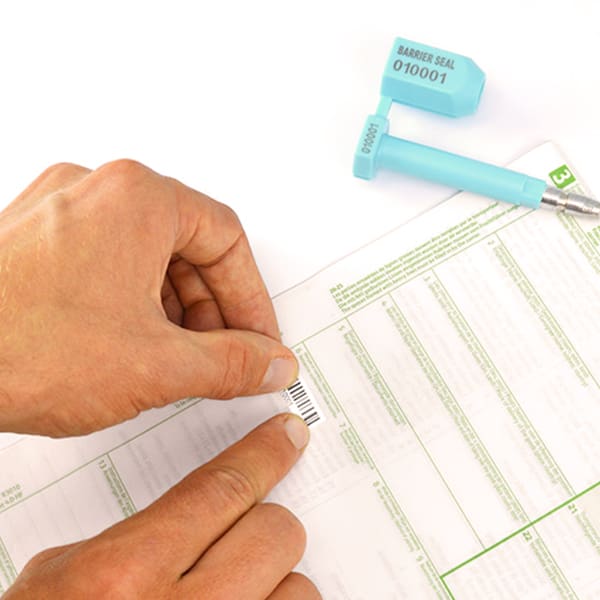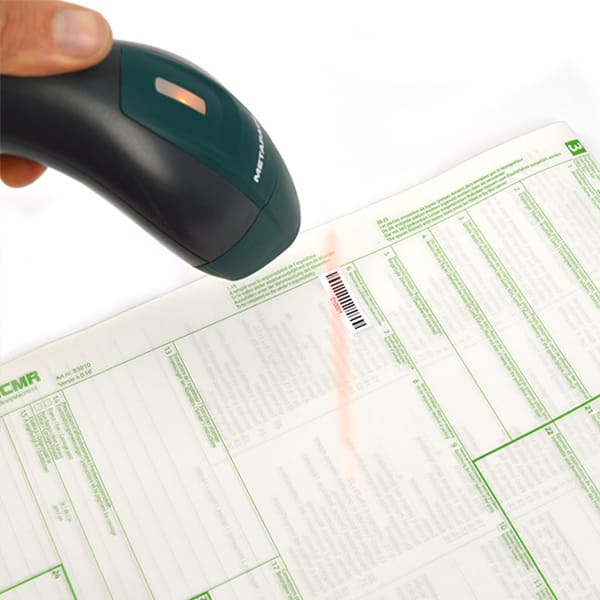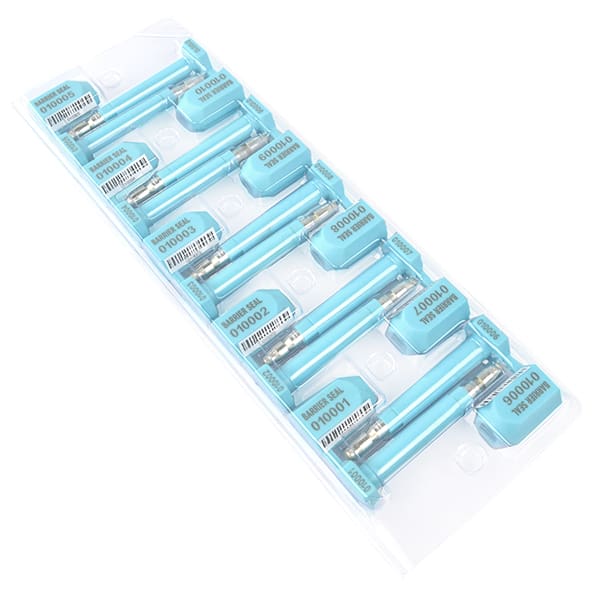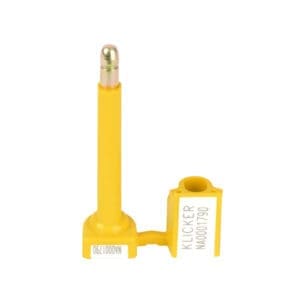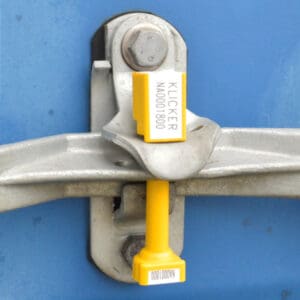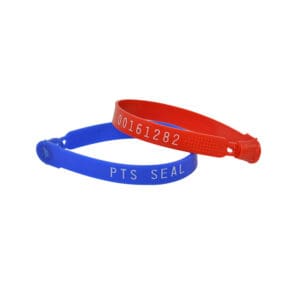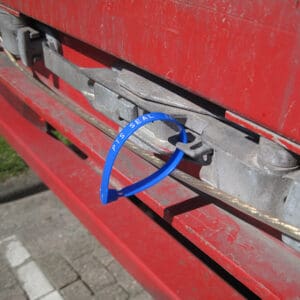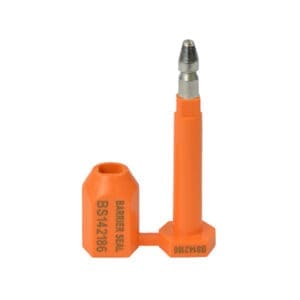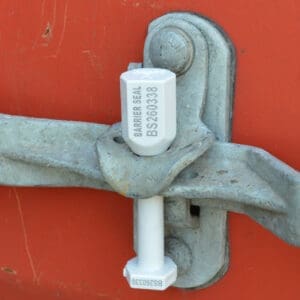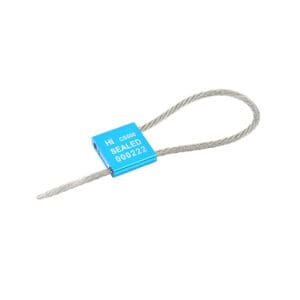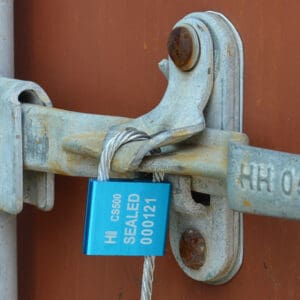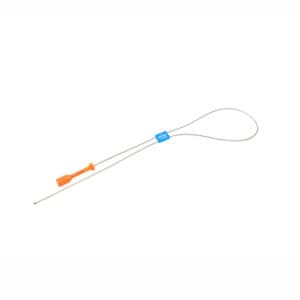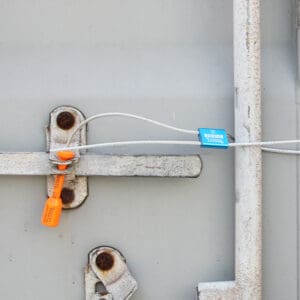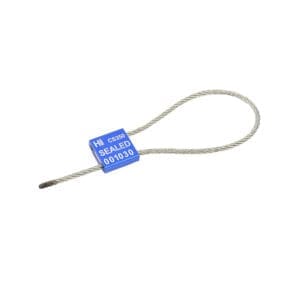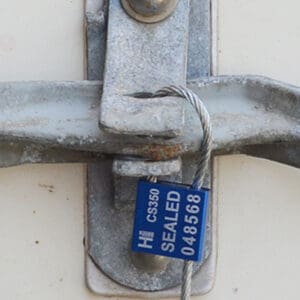| Product | Barrier Container Seal RSS |
| Total length | 94 mm |
| Pen length | 87 mm |
| Pen diameter | 8 mm |
| Breaking Strength | 1700 kg |
| Material | Steel + ABS Synthetic |
Barrier Container Seal RSS
Barrier Container Seal RSS
- Supplied with RSS Sticker (Removable Security Sticker)
- Provided with the latest ISO 17712: 2013 certificate
- Approved by customs authorities worldwide, including C-TPAT and ISPS
- With a one-off unique printing and ascending numbering
| Quantity from | 40+ | 100+ | 200+ | 600+ | 1000+ | 3000+ |
|---|---|---|---|---|---|---|
| Price per piece | €2.20 | €1.35 | €1.20 | €1.00 | €0.95 | €0.85 |
Barrier Container Seal RSS
The Barrier Container Seal RSS is just like the standard Barrier Container Seal. It is a further developed high-end container seal. The difference between the two seals is the Removable Security Sticker with barcode for the CMR. Due to its unique fraud prevention features, the container seal has the official ISO 17712: 2013 certificate. The seal has now been approved by customs authorities worldwide, including C-TPAT and ISPS. The one-off unique print and the well thought-out design make fraud pretty much impossible.
The advice is to seal with the pin down. This prevents moisture or other liquid from entering the can.
The unique properties of the Barrier Container Seal RSS
- With handy RSS (Removable Security) Sticker for the CMR
- Same quality design as the Barrier Container Seal
- Container seal with the Official ISO 17712: 2013 Certificate
- Approved by customs authorities worldwide, including C-TPAT (USA)
- Provided with a one-off unique imprint and ascending numbering (Barcode)
Equipped with handy RSS (Removable Security) Sticker for the CMR
For extra convenience, the seal is provided with a RSS sticker. The letters RSS stand for Removable Security Sticker. Just like the seal itself, the sticker has the unique numbering. The number on the sticker is identical to the number on the seal. The numbering is also shown in the form of a barcode. Easily scan the number of the seal with a barcode scanner. This saves additional time and can prevent errors in notation. The numbering of the seal must be noted on the CMR.
With the Barrier Container Seal RSS, the RSS sticker with barcode can easily be stuck to the CMR. This means that the numbering does not have to be overwritten.
Container seal provided with the official ISO 17712: 2013 Certificate
Applying ISO 17712:2013 -certified container seals in international container transport is mandatory. The Barrier Container Seal RSS has been tested and approved by an independent third party. Leading company MIRDC has tested and approved the container seal.
The process consists of two parts, namely: inspecting the product and inspecting the production process of the seal. The stamps are checked for a number of physical properties. For example, the seal must bear the manufacturer’s name, among other things. The seal must also be provided with a unique imprint and ascending numbering. Finally, the seal must bear the letter “H” which stands for High Security. As a result, container seals are also called High Security Seals.
Furthermore, the seal must be provided with a series of aspects to prevent fraud. First of all, the seal must have an anti-spin system. Second, the seal must have a minimum breaking strength, so that the seal cannot be opened without tools. Finally, both ends must be made of steel and have a minimum width. This is because the seal cannot be knocked through the lock. The aspects are tested at the MIRDC.
In addition to certifying the seal, the production process and quality assurance are also considered. Every container seal must be reliable and meet the strict requirements of ISO.
The same quality design as the Barrier Container Seal
The application of ISO certified container seals for international container transport is mandatory. The seal ensures that unauthorized persons cannot enter the container area. This can prevent fraud, damage and theft. The Barrier Container Seal RSS is, just like the standard Barrier Seal, one of the strongest and high-quality container seals available.
Like other container seals, the Barrier Container Seal RSS consists of two parts, namely a pin and a canister. The two parts can be clicked together so the seal is sealed. The seal is provided with a further developed anti-spin system. With this, the two parts of the seal cannot be loosened with, for example, a cordless drill. This is possible with many other seals, making the Barrier Container Seal RSS safer.
The second measure in the design to prevent spinning off is the design of the click system in the steel housing. The click system is in the form of a barb. This ensures that the seal cannot be spun loose. With lower quality container seals, use is made of a metal ring with a small opening, behind which the pin can be anchored. This design is more susceptible to fraud as opposed to the click system. A barb cannot be rotated too loosely.
As a third measure, the plastic (ABS) housing ensures a tighter closure. This makes it impossible to access the click system of the seal without visible damage. The ABS plastic layer also provides protection against, for example, corrosion of the container seal.
The Barrier Container Seal RSS has a steel pin with a diameter of 8 mm. At the end of the pin there is an extra deep groove behind the spherical tip. This groove clicks into the steel bush. This creates a safer closure compared to a standard seal. Reopening is not possible without visible damage.
Both ends of the seal have a diameter of 22 mm and are made of steel and ABS plastic. For example, it is not possible to hit the seal through the lock of the container. Due to the high breaking strength of 1,700 kg, the container seal can only be broken with strong bolt cutters.
Approved by customs authorities worldwide, including C-TPAT (USA)
Container lead seals with the official ISO17712: 2013 are mandatory for intercontinental transport. Customs authorities around the world only accept officially certified container seals. For example, the US Customs Authority (C-TPAT) only allow ISO certified container seals. The term C-TPAT stands for Customs Trade Partnership Against Terrorism and is a collaboration between Mexico, Canada and the United States, among others.
There is also a collaboration in the maritime sector, namely the International Ship and Port Facility Security Code, abbreviated to ISPS. This code was developed by the International Maritime Organization and aims to prevent terrorism from ships and port facilities. Again, it is mandatory to use a ISO 17712: 2013 certified container seal use.
Provided with a one-off unique imprint and ascending numbering
Each container seal is provided with a unique combination of printing and numbering. These requirements come from the ISO regulations. The Barrier Container Seal RSS is supplied from stock with the text “BARRIER SEAL” in combination with a unique ascending numbering. This in the form of a numerical number and in the form of a barcode. Both Navacqs and the manufacturer of the seal ensure that this unique combination is only produced once.
Common terms for container seals:
Container seal, container lock, high security seals

There is an option to make the Barrier Container Seal RSS extra unique by adding your own printing to the seal. For example, it is possible to include your logo or company name on the seal. The table below shows the specific possibilities with regard to personalising the Barrier Container Seal RSS.
|
Name Product
|
Barrier Container Seal RSS |
|
Colour
|
White, Orange, Yellow, Green, Red, Blue |
|
Colour Print
|
Black (Laser)
|
|
Text option
|
Yes
|
|
Logo option
|
Yes |
|
Unique numbering option
|
Yes |
|
Barcode option
|
Yes |
|
Certification
|
ISO 17712:2013
|
|
Minimum order
|
200 pcs
|
|
Est. Delivery Time*
|
approx. 1-2 weeks
|
* Please contact us for current delivery time.
Interested? We will gladly advise you!
1) Request your customised quote without obligation! Please be as specific as possible about your printing, colour and other options. Do you have any questions or special wishes? Call us at +31(0)10-4950000 or send an e-mail to sales@navacqs.com
2) We will review your specific requirements with you;
3) If required, we will send you free samples to test the Barrier Container Seal RSS;
4) We will prepare a suitable quotation for you, including expected delivery time;
5) Before the seals go into production, you will receive a proof (artwork) for approval. Only after approval will your personalised seals be produced;
6) The seals with your own imprint will be delivered within the agreed deadline. Would you like a repeat order? Please contact us. If the design is known, we can easily continue the numbering on your previous order.
Do you have any questions or comments?
Please contact us at:
+31(0)10-4950000
sales@navacqs.com
Want to try first?
Request free samples of the Barrier Container Seal RSS!
Barrier Container Seal RSS
The Barrier Container Seal RSS is just like the standard Barrier Container Seal. It is a further developed high-end container seal. The difference between the two seals is the Removable Security Sticker with barcode for the CMR. Due to its unique fraud prevention features, the container seal has the official ISO 17712: 2013 certificate. The seal has now been approved by customs authorities worldwide, including C-TPAT and ISPS. The one-off unique print and the well thought-out design make fraud pretty much impossible.
The advice is to seal with the pin down. This prevents moisture or other liquid from entering the can.
The unique properties of the Barrier Container Seal RSS
- With handy RSS (Removable Security) Sticker for the CMR
- Same quality design as the Barrier Container Seal
- Container seal with the Official ISO 17712: 2013 Certificate
- Approved by customs authorities worldwide, including C-TPAT (USA)
- Provided with a one-off unique imprint and ascending numbering (Barcode)
Equipped with handy RSS (Removable Security) Sticker for the CMR
For extra convenience, the seal is provided with a RSS sticker. The letters RSS stand for Removable Security Sticker. Just like the seal itself, the sticker has the unique numbering. The number on the sticker is identical to the number on the seal. The numbering is also shown in the form of a barcode. Easily scan the number of the seal with a barcode scanner. This saves additional time and can prevent errors in notation. The numbering of the seal must be noted on the CMR.
With the Barrier Container Seal RSS, the RSS sticker with barcode can easily be stuck to the CMR. This means that the numbering does not have to be overwritten.
Container seal provided with the official ISO 17712: 2013 Certificate
Applying ISO 17712:2013 -certified container seals in international container transport is mandatory. The Barrier Container Seal RSS has been tested and approved by an independent third party. Leading company MIRDC has tested and approved the container seal.
The process consists of two parts, namely: inspecting the product and inspecting the production process of the seal. The stamps are checked for a number of physical properties. For example, the seal must bear the manufacturer’s name, among other things. The seal must also be provided with a unique imprint and ascending numbering. Finally, the seal must bear the letter “H” which stands for High Security. As a result, container seals are also called High Security Seals.
Furthermore, the seal must be provided with a series of aspects to prevent fraud. First of all, the seal must have an anti-spin system. Second, the seal must have a minimum breaking strength, so that the seal cannot be opened without tools. Finally, both ends must be made of steel and have a minimum width. This is because the seal cannot be knocked through the lock. The aspects are tested at the MIRDC.
In addition to certifying the seal, the production process and quality assurance are also considered. Every container seal must be reliable and meet the strict requirements of ISO.
The same quality design as the Barrier Container Seal
The application of ISO certified container seals for international container transport is mandatory. The seal ensures that unauthorized persons cannot enter the container area. This can prevent fraud, damage and theft. The Barrier Container Seal RSS is, just like the standard Barrier Seal, one of the strongest and high-quality container seals available.
Like other container seals, the Barrier Container Seal RSS consists of two parts, namely a pin and a canister. The two parts can be clicked together so the seal is sealed. The seal is provided with a further developed anti-spin system. With this, the two parts of the seal cannot be loosened with, for example, a cordless drill. This is possible with many other seals, making the Barrier Container Seal RSS safer.
The second measure in the design to prevent spinning off is the design of the click system in the steel housing. The click system is in the form of a barb. This ensures that the seal cannot be spun loose. With lower quality container seals, use is made of a metal ring with a small opening, behind which the pin can be anchored. This design is more susceptible to fraud as opposed to the click system. A barb cannot be rotated too loosely.
As a third measure, the plastic (ABS) housing ensures a tighter closure. This makes it impossible to access the click system of the seal without visible damage. The ABS plastic layer also provides protection against, for example, corrosion of the container seal.
The Barrier Container Seal RSS has a steel pin with a diameter of 8 mm. At the end of the pin there is an extra deep groove behind the spherical tip. This groove clicks into the steel bush. This creates a safer closure compared to a standard seal. Reopening is not possible without visible damage.
Both ends of the seal have a diameter of 22 mm and are made of steel and ABS plastic. For example, it is not possible to hit the seal through the lock of the container. Due to the high breaking strength of 1,700 kg, the container seal can only be broken with strong bolt cutters.
Approved by customs authorities worldwide, including C-TPAT (USA)
Container lead seals with the official ISO17712: 2013 are mandatory for intercontinental transport. Customs authorities around the world only accept officially certified container seals. For example, the US Customs Authority (C-TPAT) only allow ISO certified container seals. The term C-TPAT stands for Customs Trade Partnership Against Terrorism and is a collaboration between Mexico, Canada and the United States, among others.
There is also a collaboration in the maritime sector, namely the International Ship and Port Facility Security Code, abbreviated to ISPS. This code was developed by the International Maritime Organization and aims to prevent terrorism from ships and port facilities. Again, it is mandatory to use a ISO 17712: 2013 certified container seal use.
Provided with a one-off unique imprint and ascending numbering
Each container seal is provided with a unique combination of printing and numbering. These requirements come from the ISO regulations. The Barrier Container Seal RSS is supplied from stock with the text “BARRIER SEAL” in combination with a unique ascending numbering. This in the form of a numerical number and in the form of a barcode. Both Navacqs and the manufacturer of the seal ensure that this unique combination is only produced once.
Common terms for container seals:
Container seal, container lock, high security seals
| Product | Barrier Container Seal RSS |
| Total length | 94 mm |
| Pen length | 87 mm |
| Pen diameter | 8 mm |
| Breaking Strength | 1700 kg |
| Material | Steel + ABS Synthetic |

There is an option to make the Barrier Container Seal RSS extra unique by adding your own printing to the seal. For example, it is possible to include your logo or company name on the seal. The table below shows the specific possibilities with regard to personalising the Barrier Container Seal RSS.
|
Name Product
|
Barrier Container Seal RSS |
|
Colour
|
White, Orange, Yellow, Green, Red, Blue |
|
Colour Print
|
Black (Laser)
|
|
Text option
|
Yes
|
|
Logo option
|
Yes |
|
Unique numbering option
|
Yes |
|
Barcode option
|
Yes |
|
Certification
|
ISO 17712:2013
|
|
Minimum order
|
200 pcs
|
|
Est. Delivery Time*
|
approx. 1-2 weeks
|
* Please contact us for current delivery time.
Interested? We will gladly advise you!
1) Request your customised quote without obligation! Please be as specific as possible about your printing, colour and other options. Do you have any questions or special wishes? Call us at +31(0)10-4950000 or send an e-mail to sales@navacqs.com
2) We will review your specific requirements with you;
3) If required, we will send you free samples to test the Barrier Container Seal RSS;
4) We will prepare a suitable quotation for you, including expected delivery time;
5) Before the seals go into production, you will receive a proof (artwork) for approval. Only after approval will your personalised seals be produced;
6) The seals with your own imprint will be delivered within the agreed deadline. Would you like a repeat order? Please contact us. If the design is known, we can easily continue the numbering on your previous order.
Do you have any questions or comments?
Please contact us at:
+31(0)10-4950000
sales@navacqs.com
Want to try first?
Request free samples of the Barrier Container Seal RSS!
Free samples
Would you prefer to try the product first? Request free samples of the Barrier Container Seal RSS today.
Tailor-made quotation
Do you have specific wishes regarding the Barrier Container Seal RSS? We are happy to advise you.




